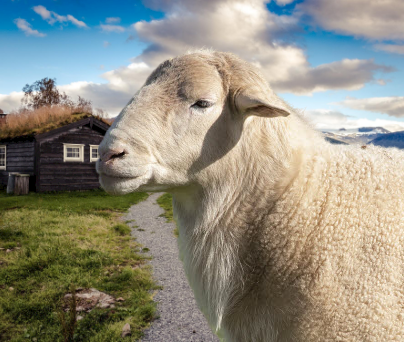The Katahdin is a breed of hair sheep that was initially developed at Piel Farm in Maine in the 1950s. The objective was to create a resilient meat sheep that did not need shearing. The hair coat, as well as toughness and procreativity, were acquired from Virgin Islands hair sheep. In order to increase both the size of the carcass and their overall quality, various wooled breeds, including the Suffolk, were employed. In order to boost the size and enhance carcass quality, the Wiltshire Horn, an English hair sheep, was also added to a limited extent in the 1970s. This breed was named after Maine's Mount Katahdin.
In the U.S., they are mostly kept as meat animals, and they have grown quite popular in recent years because shearing costs are expensive and wool prices are low. Katahdin Sheep are different because their coats are made of hair instead of wool, and they naturally lose their winter coats. This makes them much easier to care for than woollen sheep varieties.
Characteristics
Katahdin sheep range in size from medium to large, and they were the first in the United States to meet the quality standards set by the sheep industry for their carcasses. They don't need to be sheared since they naturally shed their winter coat.
In most cases, when these animals are bred with wool sheep breeds, their progeny will have a mixture of mostly wool and hair. The mature female Katahdin sheep weigh between 55 to 72 kg on average. The mature rams have a body weight of approximately 82 to 114 kg on average when they are alive.

Pros
Katahdin sheep are renowned for being resilient, low-maintenance, and adaptable to a wide range of environments. Both their capacity to produce lean, meaty carcasses and their propensity for lambing make them highly desired. They are capable of reaching 250 lbs. in weight. The majority of this weight is comprised of high-quality meat, with very minimal fat content. Katahdins are not required to be sheared because they do not produce fleece. These sheep are so productive that they may be employed to manage land. They are usually bred for meat but can sporadically be raised for milk as well. They are docile and easy to manage.
Katahdins are incredibly versatile since they are a mix of many breeds that have roots in the British Isles and the Caribbean. They develop a thicker hair covering during the winter, which they naturally slough off in the spring to reveal a smooth coat by summer.
In comparison to other sheep breeds, Katahdin sheep exhibit a high level of parasite resistance. The mothering capacity of Katahdin ewes is extraordinary. Most of the time, they lamb on their own and frequently have twins, though occasionally they have triplets or quadruplets. The mothers have enough milk for nursing.
Cons
Raising Katahdin sheep has many advantages, but there are also certain drawbacks you should be aware of. Flocking instinct is the capacity of sheep to herd together and follow one another. When keeping sheep on expansive pastures, this is a highly desired trait to seek after. Predators pose a greater risk in these areas. Katahdin sheep are not superior in this trait. Another difficulty is that Katahdin sheep may require extra feed in addition to their grass diet, particularly during the winter when their thick coats help keep them warm.











0 Comments